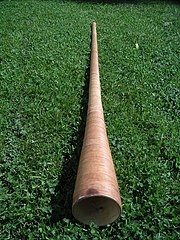
Scandinavia is a subregion of Northern Europe, with strong historical, cultural, and linguistic ties between its constituent peoples. Scandinavia most commonly refers to Denmark, Norway, and Sweden. It can sometimes also refer to the Scandinavian Peninsula. In English usage, Scandinavia is sometimes used as a synonym for Nordic countries. Iceland and the Faroe Islands are sometimes included in Scandinavia for their ethnolinguistic relations with Sweden, Norway and Denmark. While Finland differs from other Nordic countries in this respect, some authors call it Scandinavian due to its economic and cultural similarities.

The trumpet is a brass instrument commonly used in classical and jazz ensembles. The trumpet group ranges from the piccolo trumpet—with the highest register in the brass family—to the bass trumpet, pitched one octave below the standard B♭ or C trumpet.
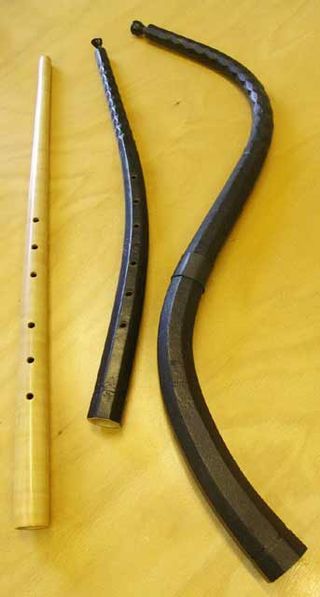
The cornett, cornetto, or zink is a wind instrument that dates from the Medieval, Renaissance and Baroque periods, popular from 1500 to 1650.

The ney, is an end-blown flute that figures prominently in Persian music, Turkish music, Jewish music and Arabic music. In some of these musical traditions, it is the only wind instrument used. The ney has been played continually for 4,500–5,000 years, dating back to ancient Egypt, making it one of the oldest musical instruments still in use.
Nordic folk music includes a number of traditions of Nordic countries, especially Scandinavian. The Nordic countries are Iceland, Norway, Sweden, Denmark and Finland.

The tenor saxophone is a medium-sized member of the saxophone family, a group of instruments invented by Adolphe Sax in the 1840s. The tenor and the alto are the two most commonly used saxophones. The tenor is pitched in the key of B♭ (while the alto is pitched in the key of E♭), and written as a transposing instrument in the treble clef, sounding an octave and a major second lower than the written pitch. Modern tenor saxophones which have a high F♯ key have a range from A♭2 to E5 (concert) and are therefore pitched one octave below the soprano saxophone. People who play the tenor saxophone are known as "tenor saxophonists", "tenor sax players", or "saxophonists".
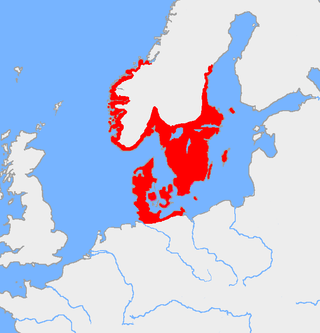
The Nordic Bronze Age is a period of Scandinavian prehistory from c. 2000/1750–500 BC.

The Scandinavian Peninsula became ice-free around the end of the last ice age. The Nordic Stone Age begins at that time, with the Upper Paleolithic Ahrensburg culture, giving way to the Mesolithic hunter-gatherers by the 7th millennium BC. The Neolithic stage is marked by the Funnelbeaker culture, followed by the Pitted Ware culture.
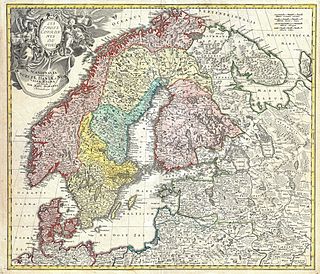
The history of Scandinavia is the history of the geographical region of Scandinavia and its peoples. The region is located in Northern Europe, and consists of Denmark, Norway and Sweden. Finland and Iceland are at times, especially in English-speaking contexts, considered part of Scandinavia.

The willow flute, also known as sallow flute, is a Nordic folk flute, or whistle, consisting of a simple tube with a transverse fipple mouthpiece and no finger holes. The mouthpiece is typically constructed by inserting a grooved plug into one end of the tube, and cutting an edged opening in the tube a short distance away from the plug.

Traditional Nordic dance music is a type of traditional music or folk music that once was common in the mainland part of the Nordic countries — Scandinavia plus Finland. The person who plays this kind of music might be called speleman (Swedish/Norwegian), spelman (Swedish), spel(l)emann (Norwegian), pelimanni (Finnish) or spillemand (Danish). Finnish traditional dance music is often called pelimanni music in English, while there does not seem to exist a similar, widespread term for the corresponding music from the other countries. It is often more meaningful to distinguish between the traditional dance music from different regions than between music from the countries as such. Some concepts in the field can be defined as Norwegian or Finnish, but most are either common to all four countries or local. Besides the dance music tradition, all countries also have other traditions of folk music that are not shared to a similar extent.
The archaeology of Northern Europe studies the prehistory of Scandinavia and the adjacent North European Plain, roughly corresponding to the territories of modern Sweden, Norway, Denmark, northern Germany, Poland and the Netherlands.
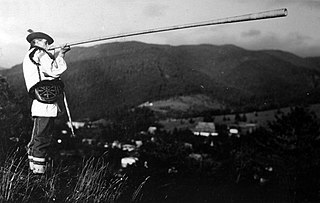
The trembita is a type of an alpine horn made of wood. It is common among Ukrainian highlanders Hutsuls who live in western Ukraine, eastern Poland, Slovakia, and northern Romania. In Poland it is known as a trombita, a bazuna, or a ligawka. Trembita is also one of the Ukrainian folk musical instruments.

The bucium is a type of alphorn from Romania and Moldova. The word is derived from Latin bucinum, originally meaning "curved horn", an instrument used by the Romans. The word is a cognate with English "bugle".
The chromatic trumpet of Western tradition is a fairly recent invention, but primitive trumpets of one form or another have been in existence for millennia; some of the predecessors of the modern instrument are now known to date back to the Neolithic era. The earliest of these primordial trumpets were adapted from animal horns and sea shells, and were common throughout Europe, Africa, India and, to a lesser extent, the Middle East. Primitive trumpets eventually found their way to most parts of the globe, though even today indigenous varieties are quite rare in the Americas, the Far East and South-East Asia. Some species of primitive trumpets can still be found in remote places, where they have remained largely untouched by the passage of time.

Svirel is a Slavic woodwind instrument of the end-blown flute type traditionally used in Russia, Belarus, and Ukraine. It is a parallel-bore flute. The six-hole versions are similar to the tin whistle; the ten-hole versions are fully chromatic.

The birch trumpet is a type of natural trumpet made of spruce covered with birch bark, known in Norway, Sweden, Finland, England, Denmark, Latvia, Lithuania, Belarus and Estonia. Even cruder and less durable versions were made of plain birch bark. They are associated with the early European Chalet culture, where it was presumably used to intimidate predators, frighten supernatural enemies, and convene council meetings.
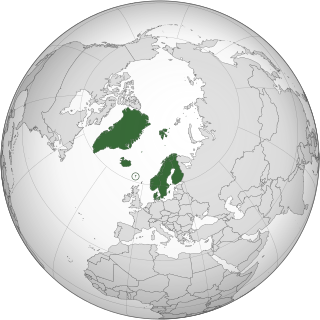
The Nordic countries are a geographical and cultural region in Northern Europe and the North Atlantic. It includes the sovereign states of Denmark, Finland, Iceland, Norway and Sweden; the autonomous territories of the Faroe Islands and Greenland; and the autonomous region of Åland.
Nordic art is the art made in the Nordic countries: Denmark, Faroe Islands, Finland, Iceland, Norway, Sweden, and associated territories. Scandinavian art refers to a subset of Nordic art and is art specific for the Scandinavian countries Denmark, Sweden and Norway.

A horn is any of a family of musical instruments made of a tube, usually made of metal and often curved in various ways, with one narrow end into which the musician blows, and a wide end from which sound emerges. In horns, unlike some other brass instruments such as the trumpet, the bore gradually increases in width through most of its length—that is to say, it is conical rather than cylindrical. In jazz and popular-music contexts, the word may be used loosely to refer to any wind instrument, and a section of brass or woodwind instruments, or a mixture of the two, is called a horn section in these contexts.

